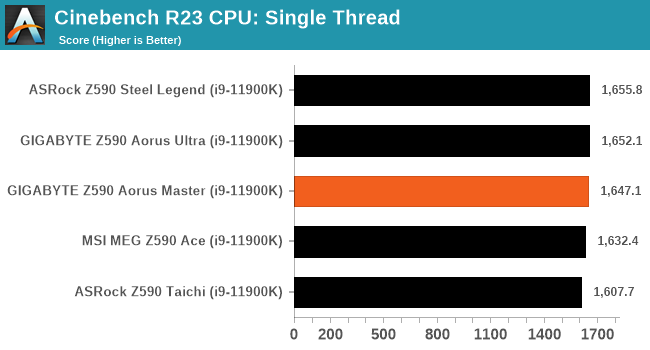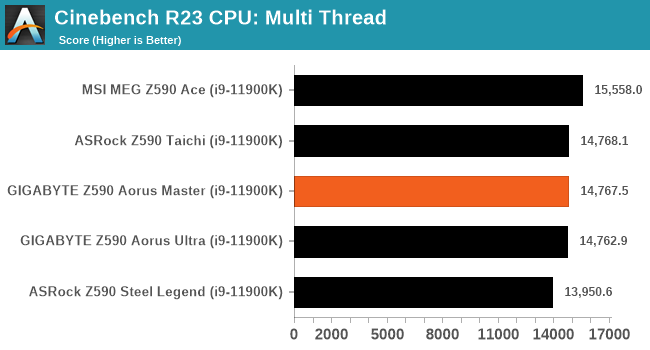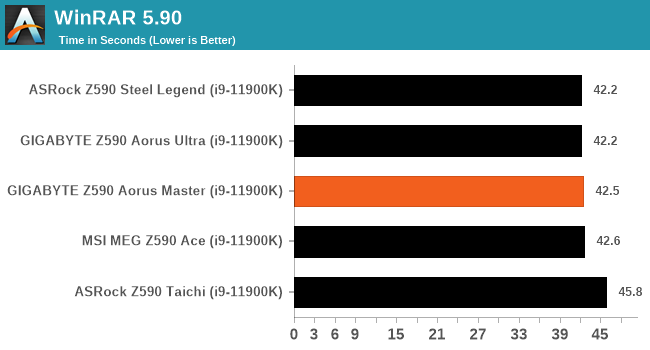GIGABYTE Z590 Aorus Master Review: Soaring High With Rocket Lake
by Gavin Bonshor on April 28, 2021 1:00 PM ESTCPU Performance, Short Form
For our motherboard reviews, we use our short form testing method. These tests usually focus on if a motherboard is using MultiCore Turbo (the feature used to have maximum turbo on at all times, giving a frequency advantage), or if there are slight gains to be had from tweaking the firmware. We put the memory settings at the CPU manufacturers suggested frequency, making it very easy to see which motherboards have MCT enabled by default.
For Z590 we are running using Windows 10 64-bit with the 20H2 update.
Rendering - Blender 2.79b: 3D Creation Suite
A high profile rendering tool, Blender is open-source allowing for massive amounts of configurability, and is used by a number of high-profile animation studios worldwide. The organization recently released a Blender benchmark package, a couple of weeks after we had narrowed our Blender test for our new suite, however their test can take over an hour. For our results, we run one of the sub-tests in that suite through the command line - a standard ‘bmw27’ scene in CPU only mode, and measure the time to complete the render.

Rendering – POV-Ray 3.7.1: Ray Tracing
The Persistence of Vision Ray Tracer, or POV-Ray, is a freeware package for as the name suggests, ray tracing. It is a pure renderer, rather than modeling software, but the latest beta version contains a handy benchmark for stressing all processing threads on a platform. We have been using this test in motherboard reviews to test memory stability at various CPU speeds to good effect – if it passes the test, the IMC in the CPU is stable for a given CPU speed. As a CPU test, it runs for approximately 1-2 minutes on high-end platforms.

Rendering - Crysis CPU Render
One of the most oft used memes in computer gaming is ‘Can It Run Crysis?’. The original 2007 game, built in the Crytek engine by Crytek, was heralded as a computationally complex title for the hardware at the time and several years after, suggesting that a user needed graphics hardware from the future in order to run it. Fast forward over a decade, and the game runs fairly easily on modern GPUs, but we can also apply the same concept to pure CPU rendering – can the CPU render Crysis? Since 64 core processors entered the market, one can dream. We built a benchmark to see whether the hardware can.
For this test, we’re running Crysis’ own GPU benchmark, but in CPU render mode. This is a 2000 frame test, which we run over a series of resolutions from 800x600 up to 1920x1080. For simplicity, we provide the 1080p test here.

Rendering - Cinebench R23: link
Maxon's real-world and cross-platform Cinebench test suite has been a staple in benchmarking and rendering performance for many years. Its latest installment is the R23 version, which is based on its latest 23 code which uses updated compilers. It acts as a real-world system benchmark that incorporates common tasks and rendering workloads as opposed to less diverse benchmarks which only take measurements based on certain CPU functions. Cinebench R23 can also measure both single-threaded and multi-threaded performance.


Compression – WinRAR 5.90: link
Our WinRAR test from 2013 is updated to the latest version of WinRAR at the start of 2014. We compress a set of 2867 files across 320 folders totaling 1.52 GB in size – 95% of these files are small typical website files, and the rest (90% of the size) are small 30-second 720p videos.

3DPMv2.1 – 3D Movement Algorithm Test: link
3DPM is a self-penned benchmark, taking basic 3D movement algorithms used in Brownian Motion simulations and testing them for speed. High floating point performance, MHz, and IPC win in the single thread version, whereas the multithread version has to handle the threads and loves more cores. For a brief explanation of the platform agnostic coding behind this benchmark, see my forum post here.

NAMD 2.13 (ApoA1): Molecular Dynamics
One frequent request over the years has been for some form of molecular dynamics simulation. Molecular dynamics forms the basis of a lot of computational biology and chemistry when modeling specific molecules, enabling researchers to find low energy configurations or potential active binding sites, especially when looking at larger proteins. We’re using the NAMD software here, or Nanoscale Molecular Dynamics, often cited for its parallel efficiency. Unfortunately the version we’re using is limited to 64 threads on Windows, but we can still use it to analyze our processors. We’re simulating the ApoA1 protein for 10 minutes, and reporting back the ‘nanoseconds per day’ that our processor can simulate. Molecular dynamics is so complex that yes, you can spend a day simply calculating a nanosecond of molecular movement.












39 Comments
View All Comments
JVC8bal - Friday, April 30, 2021 - link
I don't understand your point you responding to what I wrote. This has nothing to do with AMD vs. Intel. I guess there is a MAGA-like AMD crown on here looking for conspiracies and confrontations.As written above, the PCIE 4.0 specification implementation first found on x570 showed up on Intel's first go-around. If anything can be said, those working on the Intel platform motherboards learned nothing from prior work on the AMD platform. But whatever, read things through whatever lense you do.
TheinsanegamerN - Friday, April 30, 2021 - link
I thought it was more of a BLM- like intel crowd that looks for any pro AMD comment and tries to railroad it into the ground while dismissing whatever merit the original comment may have hadTheinsanegamerN - Wednesday, April 28, 2021 - link
I'm dissapointed that these newer boards keep cutting down on I/O. This board only offers 3 PCIe X16 slots, the third is only x4 and the second cuts half the bandwidth from the first slot despite multi GPU being long dead. So if you had, say, a sound card and a capture card, you'd have to cut your GPU slot bandwidth in half AND have one of the cards right up against the GPU cooler.IMO the best setup would have all the x1/x4 slots ont he bottom of the motherboard so you can use a tiriple slot GPU and still have 3 other cards with room between for breathing, with all the bottom slots fed fromt he chipset not the CPU.
And for those whoa re going to ask: "why do you want more expansion everything is embedded now blah blah". If you only have a GPU and dont use the other slots that's why you have mini ITX, or micro ATX if you want a bigger VRM. Buying a big ATX board for a single expansion card is a waste.
abufrejoval - Thursday, April 29, 2021 - link
While I am sure they'd love to sell you everything you're asking for, I'm less convinced you'd be ready to pay the price.You can't get anything but static CPU PCIe lane allocations out of a hard wired motherboard, with bi/tri/quad-furication already being a bonus. You need a switch on both ends for flexibility.
That's what a PCH basically is, which allows you to oversubscribe the ports and lanes.
In the old 2.0 days PCIe switch chips were affordable enough ($50?) to put next to the CPU and gain full multiple x16 slots (still switched), but certainly not without a bit of latency overhead and some Watts of power.
All those PCIe switch chip vendors seem to have been bought up by Avago/Broadcom who have racked up prices, probably less because they wanted to anger gamers, but because these were key components in NVMe based storage appliances where they knew how much they could charge (mostly guessing here).
And then PCIe 3.0 and 4.0 are likely to increase motherboard layout/trace challenges, switch chip thermals or just generally price to the point, where going for a higher lane-count workstation or server CPU may be more economical and deliver the full bandwidth of all lanes.
You can get PCIe x16 cards designed to hold four or eight M.2 SSDs that contain such a PCIe switch. Their price gives you some idea of the silcon cost while I am sure they easily suck 20 Watts of power, too.
If you manage to get a current generation GPU with PCIe 4.0, that gives you PCIe 3.0 x16 equivalent performance even at x8 lanes. That's either enough, because you have enough VRAM, or PCI 4.0 x16 won't be good enough either. At both 16 or 32GByte/s PCIe is little better than a hard disk, when your internal VRAM delivers north of 500GB/s...because that's what it takes to drive your GPU compute or the game.
The premium for the ATX form factor vs a mini ITX is pretty minor and I couldn't care less how much of the tower under my desk is filled by the motherboard. I tend to go with the larger form factors quite simply because I value the flexibility and the ability to experiment or recycle older stuff. And it's much easier to manage noise with volume.
TheinsanegamerN - Friday, April 30, 2021 - link
Boards like the gigabyte X570 elite exist, which have a plethora of USB ports and multiple additional expansion ports none of which sap bandwidth from the main port.This master is a master class is taking money for looking "cool" and offering nothing of value.
Spunjji - Thursday, April 29, 2021 - link
Agreed, that layout is a big mess and rather defeats the point of having an ATX board - but then a huge number of these are just going to go into systems that have one GPU and nothing else, but the buyer wants ATX just because that's what they're used to 🤷♂️Linustechtips12#6900xt - Thursday, April 29, 2021 - link
AGREED, my b450m pro 4 has like 4 USB 3, 1 USB-a 10gbps, 1 USB-c 10gbps and 2 USB 2.0. frankly amazing io and i couldn't appreciate it moreMolor1880 - Thursday, April 29, 2021 - link
Not completely the motherboards fault though. There are only 20 PCIe 4.0 lanes from the CPU. 4 for IO and 16 for graphics. There are no general purpose PCIe 4.0 lines off the Z590 chipset, and the DMI link is wider, but still just PCIe 3.0. When Intel starts putting general purpose PCIe 4.0 lanes on the chipset (690?), a lot of those issues would be resolved. Otherwise, it's a bit of a wonky workaround to shift things for one generation.Silver5urfer - Wednesday, April 28, 2021 - link
Unfortunately GB BIOS is not that stellar ? And why does this mobo have a fan to cool the 10G LAN chip ? I do not see that with some other boards like X570 Xtreme, X570 Prestige Creation and Maximus XIII Extreme.TheinsanegamerN - Thursday, April 29, 2021 - link
Gigabyte BIOS is fine, the UI is a tad clunky, but hey it's a huge leap from BIOSes from the core 2 era. Just takes a little getting used to.